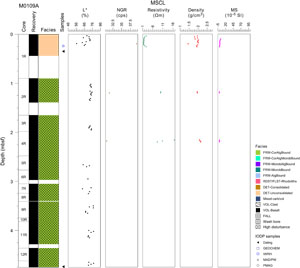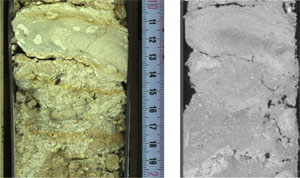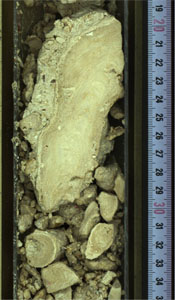Webster, J.M., Ravelo, A.C., Grant, H.L.J., and the Expedition 389 Scientists
Proceedings of the International Ocean Discovery Program Volume 389
publications.iodp.org
https://doi.org/10.14379/iodp.proc.389.116.2025
Site M01091
![]() J.M. Webster,
J.M. Webster,
![]() A.C. Ravelo,
A.C. Ravelo,
![]() H.L.J. Grant,
H.L.J. Grant,
![]() M. Rydzy,
M. Rydzy,
![]() M. Stewart,
M. Stewart,
![]() N. Allison,
N. Allison,
![]() R. Asami,
R. Asami,
![]() B. Boston,
B. Boston,
![]() J.C. Braga,
J.C. Braga,
![]() L. Brenner,
L. Brenner,
![]() X. Chen,
X. Chen,
![]() P. Chutcharavan,
P. Chutcharavan,
![]() A. Dutton,
A. Dutton,
![]() T. Felis,
T. Felis,
![]() N. Fukuyo,
N. Fukuyo,
![]() E. Gischler,
E. Gischler,
![]() S. Greve,
S. Greve,
![]() A. Hagen,
A. Hagen,
![]() Y. Hamon,
Y. Hamon,
![]() E. Hathorne,
E. Hathorne,
![]() M. Humblet,
M. Humblet,
![]() S. Jorry,
S. Jorry,
![]() P. Khanna,
P. Khanna,
![]() E. Le Ber,
E. Le Ber,
![]() H. McGregor,
H. McGregor,
![]() R. Mortlock,
R. Mortlock,
![]() T. Nohl,
T. Nohl,
![]() D. Potts,
D. Potts,
![]() A. Prohaska,
A. Prohaska,
![]() N. Prouty,
W. Renema,
N. Prouty,
W. Renema,
![]() K.H. Rubin,
K.H. Rubin,
![]() H. Westphal, and
H. Westphal, and
![]() Y. Yokoyama2
Y. Yokoyama2
1 Webster, J.M., Ravelo, A.C., Grant, H.L.J., Rydzy, M., Stewart, M., Allison, N., Asami, R., Boston, B., Braga, J.C., Brenner, L., Chen, X., Chutcharavan, P., Dutton, A., Felis, T., Fukuyo, N., Gischler, E., Greve, S., Hagen, A., Hamon, Y., Hathorne, E., Humblet, M., Jorry, S., Khanna, P., Le Ber, E., McGregor, H., Mortlock, R., Nohl, T., Potts, D., Prohaska, A., Prouty, N., Renema, W., Rubin, K.H., Westphal, H., and Yokoyama, Y., 2025. Site M0109. In Webster, J.M., Ravelo, A.C., Grant, H.L.J., and the Expedition 389 Scientists, Hawaiian Drowned Reefs. Proceedings of the International Ocean Discovery Program, 389: College Station, TX (International Ocean Discovery Program). https://doi.org/10.14379/iodp.proc.389.116.2025
2 Expedition 389 Scientists’ affiliations.
1. Operations
The multipurpose vessel MMA Valour was used as the drilling platform throughout Expedition 389. At all Expedition 389 sites, dynamic positioning was used to provide accurate positions throughout operations and water depth was established using a Sound Velocity Profiler (SVP) placed on the top of the PROD5 drilling system. For more detail on acquisition methods, see Introduction in the Expedition 389 methods chapter (Webster et al., 2025a).
Summary operational information for Site M0109 is provided in Table T1. All times stated are in Hawaiian Standard Time (HST).
1.1. Hole M0109A
The MMA Valour arrived on location at Site M0109 at 2320 h on 26 October 2023. PROD5 was deployed at 0457 h on 27 October at a water depth of 1241.8 m. Rotary coring and casing in Hole M0109A commenced at 0624 h and continued to 4.62 meters below seafloor (mbsf). The hole was terminated at 1635 h on 27 October due to a total hydraulic failure. Recovery of PROD5 and maneuvering onto the launch and recovery system proved difficult because there was no power, and it required multiple maneuvers from the vessel to turn PROD5 to the correct orientation and untwist the umbilical. PROD5 was recovered to deck at 1740 h on 27 October with all core barrels and casing. On-deck operations commenced, core barrels were extracted for curation, and repairs were undertaken. At 2130 h on 27 October, PROD5 was launched to a water depth of 1100 m for wet tests and to release any torsion in the umbilical. PROD5 was recovered at 0132 h on 28 October, and transit commenced to Site M0110.
A total of 12 cores were recovered from Hole M0109A from a total cored length of 4.62 m. The total core recovery length was 4.21 m (91.13% recovery).
2. Lithostratigraphy
Hole M0109A, spanning 0.00 to 4.75 mbsf, is located off shore from Mahakona at 1241.8 meters below sea level (mbsl). Below a thin interval of unconsolidated biodetrital sediment, recovered material from Hole M0109A consists of highly disturbed coralgal boundstone comprised mostly of branching and columnar Porites with thin coralline algal crusts.
2.1. Hole M0109A
From 0.00 to 0.44 mbsf in Hole M0109A, the cored material consists of unconsolidated biodetrital sediment (Figure F1) composed of up to cobble-sized fragments of branching Porites, laminar corals, coralline algae, bivalves, gastropods, and echinoid spines (Figure F2). Following a gap in recovery, the material from 0.90 mbsf to the base of the hole at 4.75 mbsf is characterized by highly disturbed and fragmented coralgal boundstone composed of predominantly branching, columnar, and rare laminar Porites with thin crustose coralline algal (CCA) crusts. A biodetrital coarse sediment, with fragments of coral, CCA, mollusks, and echinoid spines, occurs locally among the boundstone fragments (Figure F3).
3. Physical properties
Physical properties data for Site M0109 are shown in Table T2 in the Site M0096 chapter (Webster et al., 2025b).
3.1. Hole M0109A
A total of 2.69 m of core from Hole M0109A was scanned with the multisensor core logger (MSCL), and because the core exhibited major drilling-induced disturbance, only 15% of the acquired data passed QA/QC (see Table T10 in the Expedition 389 methods chapter [Webster et al., 2025a]). Because of the poor core quality, no discrete sample was taken for P-wave velocity and MAD measurements. Digital linescans, color reflectance, and hyperspectral imaging were acquired for all cores.
3.1.1. Density and porosity
Data for density and porosity measurements are presented in Figure F1. MSCL bulk density values range 1.44–2.15 g/cm3. Drilling-induced disturbance and short core lengths compromised data quality (see Physical properties in the Expedition 389 methods chapter [Webster et al., 2025a]), and no sampling was undertaken.
3.1.2. P-wave velocity
MSCL P-wave velocity measurements yielded no data. Core quality limited sample collection. No discrete samples were taken for P-wave velocity measurements.
3.1.3. Thermal conductivity
No thermal conductivity data were collected.
3.1.4. Magnetic susceptibility
MSCL magnetic susceptibility data range 0.06 × 10−5 to 4.17 × 10−5 SI (Figure F1), and the majority of magnetic susceptibility values are close to 1.11 × 10−5 SI. There are no apparent downhole trends.
3.1.5. Electrical resistivity
MSCL noncontact resistivity measurements range 1.47–16.69 Ωm (Figure F1). There are no apparent downhole trends or notable features.
3.1.6. Natural gamma radiation
MSCL natural gamma radiation values range 31–39 counts/s (Figure F1) and show no apparent downhole trends.
3.1.7. Digital linescans, color reflectance, and hyperspectral imaging
All cores were digitally scanned, measured for color reflectance (where appropriate), and imaged with the hyperspectral scanner (see HYPERSPECTRAL in Supplementary material). Color reflectance L* values vary between 56% and 78% (Figure F1), a* varies between 0.53 and 2.58, b* varies between 9.46 and 22.24, and a*/b* varies between 0.04 and 0.15.
4. Geochemistry
4.1. Interstitial water
One interstitial water sample was collected from Hole M0109A at 0.24 mbsf (1R-1, 23.5–23.5 cm). The interstitial water potassium concentration was lower compared to seawater (see Tables T15 and T16 in the Expedition 389 methods chapter [Webster et al., 2025a]). Manganese concentration was low but measurable compared to other interstitial water samples from Expedition 389. Major ion concentrations in this sample are within a range similar to that of other Expedition 389 interstitial samples.
4.2. Surface seawater
One surface seawater sample was collected from Site M0109 using a Niskin bottle deployed from the side of the vessel (see Figure F22 in the Expedition 389 methods chapter [Webster et al., 2025a]). The salinity, pH, alkalinity, and concentrations of ammonium were analyzed off shore, and major cations and anions were measured during the Onshore Science Party. The salinity, pH, alkalinity, ammonium, and major element chemistry measured for the Site M0109 seawater sample are consistent with the other surface seawater samples taken during Expedition 389 and align with the expected values for conservative elements in seawater (see Tables T15 and T17 in the Expedition 389 methods chapter [Webster et al., 2025a]).
4.3. Bulk sediment
Because of the short length of the core, no bulk sediment samples were taken from Site M0109.
5. Paleomagnetism
Because the recovered core lithologies were not suitable for sampling, no samples were analyzed for paleomagnetic properties for Site M0109.
6. Geochronology
Two U-Th dates were obtained from Hole M0109A (see Tables T21 and T22 in the Expedition 389 methods chapter [Webster et al., 2025a]). Dates from both samples (1R-1, 35–36 cm, and 12R-1, 38–39 cm) are rejected based on anomalous δ234U initial values (below 130‰ or above 160‰). The date from Sample 1R-1, 35–36 cm, is also rejected based on a very high uncertainty due to being near secular equilibrium. Therefore, there are no reliable dates obtained from this site.
References
Webster, J.M., Ravelo, A.C., Grant, H.L.J., and the Expedition 389 Scientists, 2025. Supplementary material, https://doi.org/10.14379/iodp.proc.389supp.2025. In Webster, J.M., Ravelo, A.C., Grant, H.L.J., and the Expedition 389 Scientists, Hawaiian Drowned Reefs. Proceedings of the International Ocean Discovery Program, 389: College Station, TX (International Ocean Discovery Program).
Webster, J.M., Ravelo, A.C., Grant, H.L.J., Rydzy, M., Stewart, M., Allison, N., Asami, R., Boston, B., Braga, J.C., Brenner, L., Chen, X., Chutcharavan, P., Dutton, A., Felis, T., Fukuyo, N., Gischler, E., Greve, S., Hagen, A., Hamon, Y., Hathorne, E., Humblet, M., Jorry, S., Khanna, P., Le Ber, E., McGregor, H., Mortlock, R., Nohl, T., Potts, D., Prohaska, A., Prouty, N., Renema, W., Rubin, K.H., Westphal, H., and Yokoyama, Y., 2025a. Expedition 389 methods. In Webster, J.M., Ravelo, A.C., Grant, H.L.J., and the Expedition 389 Scientists, Hawaiian Drowned Reefs. Proceedings of the International Ocean Discovery Program, 389: College Station, TX (International Ocean Discovery Program). https://doi.org/10.14379/iodp.proc.389.102.2025
Webster, J.M., Ravelo, A.C., Grant, H.L.J., Rydzy, M., Stewart, M., Allison, N., Asami, R., Boston, B., Braga, J.C., Brenner, L., Chen, X., Chutcharavan, P., Dutton, A., Felis, T., Fukuyo, N., Gischler, E., Greve, S., Hagen, A., Hamon, Y., Hathorne, E., Humblet, M., Jorry, S., Khanna, P., Le Ber, E., McGregor, H., Mortlock, R., Nohl, T., Potts, D., Prohaska, A., Prouty, N., Renema, W., Rubin, K.H., Westphal, H., and Yokoyama, Y., 2025b. Site M0096. In Webster, J.M., Ravelo, A.C., Grant, H.L.J., and the Expedition 389 Scientists, Hawaiian Drowned Reefs. Proceedings of the International Ocean Discovery Program, 389: College Station, TX (International Ocean Discovery Program). https://doi.org/10.14379/iodp.proc.389.103.2025


